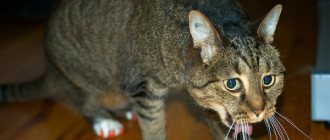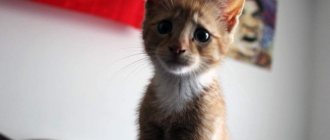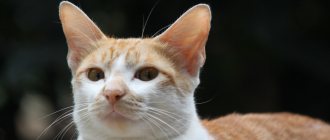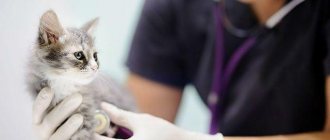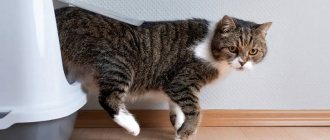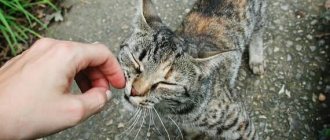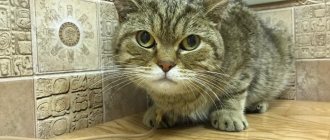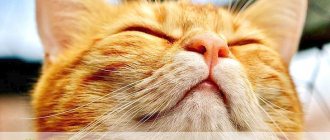11569Administration
Animals, unlike people, do not suffer from common colds. If a cat has snot and watery eyes, this is almost always a sign of a serious illness and a reason to visit the veterinarian. Premature panic will only aggravate the situation, and your task is to analyze the symptoms and find possible causes of the ailment.
Excessive snot from the nose and sore eyes indicate that the cat’s body is trying to heal on its own. The discharge protects the sensitive mucous membrane and prevents the penetration of dust.
Depending on the external appearance of the snot, the doctor can determine the causes of a runny nose in a cat.
The allocations are divided into:
- Transparent and opaque, stretchy or liquid;
- White, yellow, red, gray-green;
- Snot flows continuously or intermittently;
- After leaking, they form crusts or come out freely.
© shutterstock
Healthy eyes in a cat
Only a veterinarian can answer the exact question of why a cat sneezes and why her eyes are watery. He must first conduct an examination of her condition.
However, you should not immediately panic; sometimes increased secretion of clear fluid from the eyes and representatives of the cat family is considered a normal condition. But it is worth considering the condition of the eyes.
The production of clear tears is considered normal if the eyes:
- clear, if there are no opacities or injuries;
- if the conjunctiva is pale pink or has a physiologically pigmented structure;
- have no swelling and are not accompanied by pain;
- having a shiny cornea and a pupil that adequately perceives exposure to bright light;
- without obvious signs of foreign bodies;
- in parallel are not accompanied by additional secretions of various types.
Note! Some cat breeds have anatomical lacrimation, this is due to the structure of the nose. These manifestations are typical for the Scots, Persians and British.
Persians have a curvature of the lacrimal canal, and in the Scots it is very short. Persians have a curvature of the lacrimal canal, and in the Scots it is very short. But the British cat exhibits lacrimation, which is transmitted at the genetic level. In order to alleviate the animal's condition, the eyes should be washed every day, and special eye drops can also be instilled.
Tearing is considered normal if it occurs in the morning. Often, in the morning, owners discover white discharge in the corners of their pet’s eyes without obvious signs of inflammation. And after waking up, the appearance of fluid from the tear ducts ensures the cleansing of accumulations of secretions and crusts.
Age-related lacrimation in kittens is considered normal. In animals, about a week after eye opening, active secretion of fluid may be observed. It is worth carefully examining the kitten's eyes; they should not be inflamed, and the liquid itself should be clear and liquid.
Preventive actions
As they say, it is better to prevent a disease than to cure it. Various preventive measures will help you avoid troubles such as sneezing and snot in your cat. One of the effective measures is vaccination! If you regularly carry out examinations and give your cat vaccinations, you can avoid allergies and other diseases of this kind. So don’t delay getting vaccinated.
Here is a list of diseases for which a cat needs regular vaccination:
- Rabies.
- Leukemia.
- Cat flu and various viral infections.
Let your pet live a fulfilling and healthy life. Do not spread illnesses , maintain hygiene and pay attention to the slightest deviation from your usual state. Give love and daily, monthly, and annual care. Prevention is better than cure. Believe me, nothing human is alien to our pets. And they also want to be strong, well-groomed, healthy and attractive to the opposite sex. So give them this opportunity!
Causes
So why does a cat's eyes water? It is worth carefully considering the main reasons that provoke the development of this condition. They will help in the future to provide correct and effective treatment.
The most common factors that provoke increased secretion of tears from the eyes include the following:
- eye injuries and bruises. These include mechanical damage to the eyes or eyelids, which can be sustained during a fight with street cats. But in most cases, animals injure themselves on their own. They may scratch the eye with a claw or get hit hard. The cat can also be scratched by plants and dry grass stems. In addition to tearing, other unpleasant symptoms may appear - inflammation, severe redness, swelling, discharge;
- entry of a foreign body. When a small grain of sand, speck, or piece of glass penetrates the mucous membrane of the eye, it can cause unbearable pain and severe discomfort. If a foreign body has become permanent, you can help your pet at home. To do this, you need to rinse your eye with clean water, and after that with a solution of any antibiotic, this remedy will help prevent the inflammatory process. If the foreign body has penetrated deep into the cornea of the eye, then it is better to contact a veterinarian;
- burns. These lesions can be of two types - thermal and chemical. If you want your pet’s eyes to always be in perfect order, then it is better to further remove all aggressive mixtures - paints, solvents, varnishes, household chemicals. If it was not possible to avoid a burn and the animal reached the chemical agent, then you should immediately take it to an appointment with a veterinarian. It is advisable to first study the composition of the aggressive agent so that the doctor can prescribe effective treatment;
- allergic reaction. Often, increased tear production occurs as a result of an allergy to a specific irritant. An irritating factor can be dust, tobacco smoke, new food, pollen from plants, citrus fruits, household chemicals, cosmetics. In these cases, the cat develops a runny nose and watery eyes. Since it is not always possible to independently determine the allergen that causes these unpleasant phenomena in an animal, an examination and a series of tests to determine it may be required;
- trichiasis This phenomenon is considered rare, but it all occurs sometimes. During this process, eyelashes grow inside the eye. This process is accompanied by severe discomfort; the animal’s eyes are constantly red and swollen. The only treatment option is surgery;
- worms. If your cat's eyes are watery, it may be due to the presence of worms. The presence of helminths causes an inadequate reaction of the body, which can manifest itself in the form of excessive tearfulness;
- conjunctivitis and its forms (blepharitis, fungal infection, viral infections). This is one of the most common ophthalmological pathologies, which is accompanied by profuse secretion of tears from the eyes;
- cold. In addition to the secretion of tears, purulent discharge is observed, and the cat also exhibits snot.
Nasal discharge.
They, as protection against dust and germs, are normally always present during washing.
If they become abundant, then the cause may range from simple irritation to problems with parasites, fungi, tumors, but if the kitty is still sneezing and breathing heavily, it means it is already seriously ill.
In the case of yellow or green snot, purulent and serous discharge with the formation of crusts, also the presence of blood in them, swelling of the muzzle - the diagnosis can be no less terrible! All infections develop very quickly and require immediate medical attention!
For example, for rhinitis - inflammation in the nasal passages, in which the protective secretion is produced especially strongly, experts prescribe:
- various types of warm nasal rinses (the simplest: 1 teaspoon of salt in 1 liter of water, boil for 2 minutes, strain) using a convenient insulin syringe without a needle: pour 0.5 ml into the nostril, and as soon as the cat snorts and sneezes, the passage will become free, then you can wash the second passage;
- warming with a warm bag of salt or sand (not possible if the mucus is yellow or green!);
- treatment with sea buckthorn oil and oxolinic ointment;
- instillation of naphthyzine for children;
- antibiotics.
When hit by a small particle or insect, the animal sneezes and is usually released in this way. And if he doesn’t succeed, then you can first try to carefully remove the speck yourself with tweezers. Sometimes mucus comes out of a damaged nostril along with blood. Then contact your veterinarian, because in difficult cases you will need an x-ray and even extraction under anesthesia.
Cancer in the nasal cavity has many symptoms, including discharge, sneezing, loss of appetite, lethargy, bleeding and foul odor. The success of treatment depends on the stage and takes place in the hospital.
Establishing diagnosis
Before starting treatment, it is imperative to conduct a diagnosis that will help identify the true cause of excessive lacrimation and carry out effective treatment therapy. Only a veterinarian can conduct a correct and thorough examination.
Important! Before going to the veterinarian, be sure to prepare a pet card, which should indicate all vaccinations, anthelmintic treatments, and past illnesses. It is advisable to write down symptoms of malaise and other suspicious signs on a piece of paper.
Sometimes the veterinarian may be interested in the following important questions at the appointment:
- how long the symptoms last;
- how did the first symptoms of tearing from the eyes appear and the peculiarities of the course of this condition, for example, did two eyes immediately begin to water at the same time, or vice versa, first one began, and then the other, and whether there are other additional symptoms;
- when the last procedures to eliminate helminths, fleas, ticks and other parasites were carried out.
To make an accurate diagnosis, the veterinarian will definitely take a urine and stool test. It is advisable to already have the research material with you before going to the doctor. Also, at the appointment, he will definitely take mucus from the eye for examination; for this reason, there is no need to first rinse the pet’s eyes with various solutions.
Treatment
The vision of cats is considered an important function that animals require for a full life. The vision of cats is considered an important function that animals require for a full life. For this reason, it is important to carefully and regularly monitor the condition of your pet's eyes. And if you detect excessive lacrimation, and even more so discharge with signs of pus, there is no need to self-medicate.
It is worth noting! The veterinarian prescribes medications depending on the condition of the eyes and the type of discharge in the animal. For local effects, drugs are usually prescribed in the form of drops.
You can treat your cat’s eyes at home using special products that can be used without a doctor’s prescription:
- You can wash your animal’s eyes with furatsilin with a concentration of 0.2%. This remedy can be used for conjunctivitis. You can also use other solutions with antiseptic effects;
- Levomycetin (aqueous solution). This remedy is used for bacterial conjunctivitis. Drugs in the form of drops - Kanamycin or Sofradex - also have a good effect;
- ointments containing antibiotic components. The main thing is to apply the ointment correctly to the eyes so as not to cause even more harm. This remedy should be applied several times a day;
- solution of hydrocortisone or novocaine. These drugs should be administered by injection. They help reduce pain;
- use of an anesthetic and sodium chloride with a concentration of 8.5%. If a foreign body, speck, or debris gets into the animal’s eyes, then he needs to be given an analgesic. After the drug has taken effect, you need to take a cotton swab, turn out the cat’s eyelid and carefully remove the speck using cotton wool;
- For allergic reactions in cats, treatment is accompanied by the use of hormonal drugs.
How to treat at home?
If you decide to treat your cat at home, then remember that this should be done based on the cause of the disease:
- Worms can be cured with special medications. Including Bothionol and Phenothiazine.
- Lysine is effective against sneezing caused by herpes.
- Mold allergies are treated with special ointments.
- If the cause is dental, the doctor will give the necessary recommendations and prescribe medications.
- Keeping your cat away from the source of your allergy, keeping your home clean, and monitoring your cat's activities will be an effective way to combat allergies.
